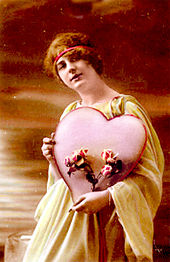The History of Valentine’s Day and What It Has Come to Mean Today
Valentine’s Day is a holiday that most people observe due to its popularity in our culture. But where did it begin and why do we set aside the date of February 14th each year for this observance? That is the question I aimed to answer in researching this holiday tha t is now widely observed worldwide.
t is now widely observed worldwide.
Historical references of a Valentine’s Day- like holiday during February go back to Ancient Greece which celebrated the month of Gamelion from mid-January to mid-February in honoring the sacred marriage of Zeus and Hera. Meanwhile, in Ancient Rome, a celebration of fertility was taking place at the festival of Lupercalia, February 13–15.
Valentine’s Day or “Saint Valentine’s Day” actually dates back to the early Christian era in Ancient Rome with a liturgical celebration of Saint Valentinus who was martyred for ministering to Christians and secretly providing marriages for Roman soldiers, who were prohibited to marry. In Slovenia, Saint Valentine or “Zdravko” later became the patron saint of beekeepers and pilgrims in association with good health and the season of spring. Saint Valentine is also celebrated as the patron saint of Lebanon by a large portion of the population.
Chaucer is Commonly Associated with Valentine’s Day Being an Observance of Love
About 1,000 years later, English poet Geoffrey Chaucer wrote “Parlement of Foules” in 1382:
“For this was on seynt Volantynys day, Whan euery bryd comyth there to chese his make.”
[“For this was on St. Valentine’s Day, when every bird cometh there to choose his mate.”]That poem is attributed to the creation of the holiday of Valentine’s Day as a testament to romantic love.
The Holiday Originates in England and Then Comes to America Through Worcester, MA Artist
The trend of exchanging hand-made valentines started growing in England in the 18th century then grew to include gifts of flowers and confectionaries. When Worcester, Massachusetts artist Esther Howland received an ornate valentine from a business associate of her father’s in 1847, she decided to begin producing her own with imported lace and paper from England. Her business quickly grew as the trend expanded with her earning $100,000 a year from her small business. Esther, a graduate of Mt. Holyoke College, has since become known as the “Mother of the American Valentine” and my hometown of Worcester, MA is known as the “Heart of the Commonwealth,” with a heart as its official symbol.
During the 2nd half of the 20th century, gifts like roses and heart-shaped boxes of chocolate also became popular for Valentine’s Day. In the 1980’s, the diamond industry joined the fray by promoting Valentine’s Day as a time for getting engaged and for special jewelry purchases.
Today, the Greeting Card Association estimates over one billion paper valentines are exchanged each year in the United States with teachers receiving the most highest percentage. Digital communications have further expanded Valentine’s Day as e-cards and love coupons have become available.
How Other Countries Celebrate Valentine’s Day
In many Latin American countries including: Mexico, Columbia, Costa Rica and Puerto Rico, Valentine’s Day is known as “El Día de los Enamorados” (Day of Lovers) or as “Día del Amor y la Amistad” (Day of Love and Friendship). In Guatemala, “Día del Cariño” (Affection Day) is celebrated on February 14th while in other countries, both Día del Amor y la Amistad and the Amigo Secreto (“Secret Friend”) are celebrated together.
Since 1992, India has partaken in the holiday. This trend has actually changed the very old customs regarding displays of public affection more than any other ritual since the Middle Ages. Russia, too, observes Valentine’s Day now and has since the fall of the USSR.
Of the Asian countries, Singapore is noted to have the highest expenditure for Valentine’s Day gift giving, followed by South Korea and China. Japan, Taiwan, China and South Korea celebrate the holiday with women giving gifts of chocolate to men, who then reciprocate by giving chocolates and other gifts to women on “White Day,” celebrated March 14th.
In the Philippines, Valentine’s Day is called Araw ng mga Pusò (“Day of Hearts”) and is celebrated in much the same manner as in the West. In Spain, Wales, Scandinavia, Romania, Portugal, France, Finland and Estonia, Valentine’s Day is often celebrated as a romantic holiday.
Where NOT to Celebrate Valentine’s Day
Traditional Hindu and Islamic countries oppose the practice of Valentine’s Day, believing it to be cultural contamination from the West. These countries include Malaysia, Saudi Arabia, Pakistan, Iran and parts of India. In 2014, religious police in Saudi Arabia were reported to have arrested five men for celebrating St. Valentine’s Day in the company of six women. The Buraidah criminal court pronounced sentences totaling 32 years’ imprisonment and 4,500 lashes to the men.
Do You Have to Be “In Love” to Celebrate?
For a long time, singles were stigmatized by the Valentine’s Day holiday, feeling ‘left out’ of the celebration or sometimes seeing it as a failure in the romantic department. As the holiday has taken on more of a commercial glare, it’s important to note its origins as a celebration of the spring, of birds finding their mates, or as a good time to plant crops. Whether you celebrate Valentine’s Day with chocolates, roses, greeting cards — or not at all, the sentiment of love and appreciation is what this holiday is really all about.
